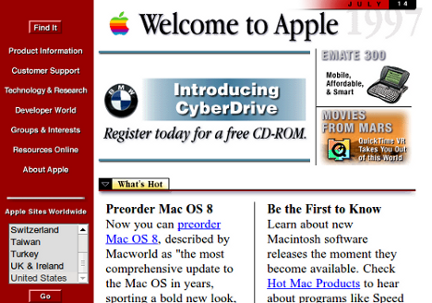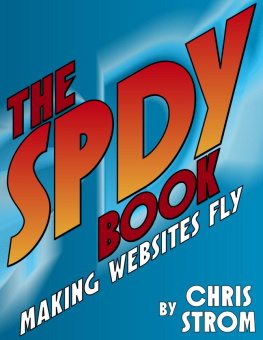Chris Strom - The SPDY Book: Making Websites Fly
Here you can read online Chris Strom - The SPDY Book: Making Websites Fly full text of the book (entire story) in english for free. Download pdf and epub, get meaning, cover and reviews about this ebook. genre: Computer. Description of the work, (preface) as well as reviews are available. Best literature library LitArk.com created for fans of good reading and offers a wide selection of genres:
Romance novel
Science fiction
Adventure
Detective
Science
History
Home and family
Prose
Art
Politics
Computer
Non-fiction
Religion
Business
Children
Humor
Choose a favorite category and find really read worthwhile books. Enjoy immersion in the world of imagination, feel the emotions of the characters or learn something new for yourself, make an fascinating discovery.
- Book:The SPDY Book: Making Websites Fly
- Author:
- Genre:
- Rating:4 / 5
- Favourites:Add to favourites
- Your mark:
- 80
- 1
- 2
- 3
- 4
- 5
The SPDY Book: Making Websites Fly: summary, description and annotation
We offer to read an annotation, description, summary or preface (depends on what the author of the book "The SPDY Book: Making Websites Fly" wrote himself). If you haven't found the necessary information about the book — write in the comments, we will try to find it.
Chris Strom: author's other books
Who wrote The SPDY Book: Making Websites Fly? Find out the surname, the name of the author of the book and a list of all author's works by series.
The SPDY Book: Making Websites Fly — read online for free the complete book (whole text) full work
Below is the text of the book, divided by pages. System saving the place of the last page read, allows you to conveniently read the book "The SPDY Book: Making Websites Fly" online for free, without having to search again every time where you left off. Put a bookmark, and you can go to the page where you finished reading at any time.
Font size:
Interval:
Bookmark:
<>The SPDY Book is copyright 2011, by Chris Strom. All rights reserved.
If you didnt pay for this book, please do the right thing and compensate me for my time at spdybook.com. If you dont want to fork over a bit of cash, nearly all of my notes are available for free:
http://japhr.blogspot.com/2011/04/my-chain-3.html
But seriously, do the right thing.
- 2011-06-30: First beta release.
- 2011-07-05: Formatting changes. Copy edits from Ashish Dixit.
- 2011-07-19: New application-centric chapters at the beginning of the book. Thanks to Dave Thomas for the suggestion. New chapter on control frames. Incorporate many suggestions from Mike Belshe.
- 2011-07-28: Last two chapters.
- 2011-07-29: More alternatives chapter work. Suggestions from Jeff Dallien, Mike Belshe and Gautam Dewan.
- 2011-07-30: Finally write the wireshark appendix. Corrections from Jeff Dallien.
- 2011-07-31: Final release. Add example of what is possible for future use. Many, many edits.
How could this book be dedicated to anyone besides my wife? Not only did she put up with 99 straight days of my obsession, she helped every step of the way. Quite beyond just being patient, she gave of her time and even served as the primary editor of this book. Robin, I dont know how you do it all, but I love you!
Huge thanks to all of my beta readers. Even the smallest copy suggestions were of great help in helping the overall quality of the book. Special thanks to Jeff Dallien, Gautam Dewan and Ashish Dixit for multiple suggestions. How you guys find the time to provide such thoughtful, helpful comments, I do not know. But Im grateful that you do!
I am quite grateful to Dave Thomas for his comments on the overall structure of the book. The SPDY Book would have been much poorer for it if he had not pointed me in the right direction.
Special thanks to Mike Belshe for technical insight into the book and his sometimes nightly guidance on my blog. And, of course, thanks for helping to write the SPDY spec in the first place! I can only hope that this book adds to the great work that you have already done.
HTTP is an astonishing accomplishment.
Originally created 20 years ago and last updated more than 10 years ago, it is hard to understate what has been accomplished with it.
Conceived and solidified before iTunes and iPads, before Android and before Facebook, it has nevertheless allowed those things to thrive.
SPDY is not meant to stave off some imminent collapse. HTTP and browsers are not in dire shape.
But there is still waste. There is still room for improvement. There are many, many lessons learned in the past 10 years.
Google has made a first attempt to describe what a protocol built for the future might look like. At the time of this writing, SPDY is not even an IETF [] recommendation.
It is barely a gleam in its parents' collective eye. And yet it is still important. Possibly vitally important to the future.
It is called SPDY and its name is meant to evoke its purpose: PAGE LOAD SPEED.
After reading this book, I hope that you will:
- understand the problems that SPDY is trying to solve
- be fluent in SPDY sessions, including reading individual packets
- SPDY-ize your own siteseither by writing your own SPDY parser or using one of the frameworks discussed.
This book is primarily intended for web developers, mobile application developers and network administrators.
It is ideal for anyone wanting to make their sites faster. Even if you decide that you do not want to use SPDY, there ought to be oodles of tidbits that you can apply to your existing HTTP/1.1 sites.
SPDY is built on top of HTTP. It is meant to transport web traffic. As such, good HTTP fundamentals will help when reading this book. Even so, you need not be an expert on all things RFC 2616 []. Wherever possible, I try to explain the HTTP involvedespecially as it relates to SPDY.
By profession, I am a Ruby and Node.js hacker. As such, I will focus my discussion on the SPDY gem from Ruby and the node-spdy module from node-land.
Even if you have little-to-no experience with Ruby, I try to keep the Ruby code samples very readable (one of Rubys hallmarks). I do assume some experience with Javascriptespecially in later chapters.
Given that SPDY has yet to be submitted as a recommendation to any standards body, it can be legitimately asked: is a book such as this too early?
Maybe, but I would argue not. Well duh, I wrote the damn thing, but heres why
The problems that SPDY tries to solve are not going to magically go away.
Even though SPDY is not yet a formal recommendation, it has gone through two drafts. A third draft is underway at the time of this writing. After the third draft is complete, SPDY will be submitted to the IETF. Bottom line: this may be the perfect time for a book!
Regardless, I am not writing the definitive guide to SPDY. It is my hope that this will be a solid grounding in SPDY fundamentals and no more.
33% of broadband users would rather close the browser tab loading your site than wait 4+ seconds []. You need to be doing everything in your control to ensure that your site is reliably available to users all over the world in less than 4 seconds.
You could spend time and resources implementing numerous suggestions for page speed []. Or you can embrace a technology supported by the fastest growing browser on the market (Googles Chrome).
SPDY comes with the promise of reducing page load time by 50%. If your site takes 8 seconds, you can almost immediately realize the goal of a 4 second site. If your site takes less time, you can make your site even faster or add cool new features that you wouldnt dare add today.
SPDY promises faster sites, but also more reliable sites. SPDY works with the underlying TCP/IP networking layer instead of abusing it like HTTP does [].
Currently, SPDY is only available for the Chrome browser, but how much longer can other browser vendors ignore SPDY if it makes things 50% faster?
How long can you afford to ignore it?
[
[
[
[
[
In the Beginning
the web was simple. Web sites were simple. Web pages were simple.
Sites had few pages. There was little interactivity.
There were one or two images. All styling took place within the HTML itself. Simple

And HTTP/1.0 was plenty.
Then the web grew. Users needed more and sites wanted to provide more. Pages got larger. Javascript was introduced to provide dynamic client-side interaction. Styles were split out into CSS stylesheets. More images were added.

And HTTP/1.1 was plenty.
But that was 10 years ago.
It is remarkable that the web has evolved as it has all on the back of HTTP/1.1. We have seen the rise of Google, Amazon, Facebook and Twitter. All on the back of HTTP/1.1.
Font size:
Interval:
Bookmark:
Similar books «The SPDY Book: Making Websites Fly»
Look at similar books to The SPDY Book: Making Websites Fly. We have selected literature similar in name and meaning in the hope of providing readers with more options to find new, interesting, not yet read works.
Discussion, reviews of the book The SPDY Book: Making Websites Fly and just readers' own opinions. Leave your comments, write what you think about the work, its meaning or the main characters. Specify what exactly you liked and what you didn't like, and why you think so.











